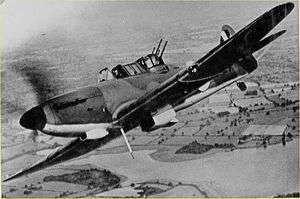727 Naval Air Squadron
| 727 Naval Air Squadron | |
|---|---|
|
727 NAS badge | |
| Active |
26 May 1943 - 7 December 1944 23 April 1946 - 17 January 1950 4 January 1956 - 16 December 1960 6 Dec 2001 - present |
| Country |
|
| Branch | Fleet Air Arm of the Royal Navy |
| Role | Flying grading for potential aircrew |
| Garrison/HQ | RNAS Yeovilton |
| Motto(s) |
Regite mare, regere caelum (Latin: "To rule the sea, rule the sky") |
727 Naval Air Squadron is a squadron of the Royal Navy Fleet Air Arm. It was formed in 1943 as a Fleet Requirements Unit, being disbanded in December 1944. It was reformed twice in the 1940s and 1950s to provide flying experience for naval officers. The current squadron was created on 6 Dec 2001 from the Royal Naval Flying Training Flight. It operates the Grob Tutor and provides grading and acquaint flights for Royal Navy and Royal Marine pilots under training, as well as supporting the Royal Navy's "Flying Start" flying scholarship scheme.
History of 727 NAS
Fleet Requirements Unit (1943 - 1944)
727 Naval Air Squadron was formed on 26 May 1943 at Gibraltar as a Fleet Requirements Unit covering the area from Bizerta to Algiers. The squadron was equipped with target-towing[1] Boulton Paul Defiants, Fairey Swordfish and Hawker Hurricane IIc. The squadron was disbanded on 7 December 1944.[2]
Air Experience Unit (1946 - 1960)
After World War II it was decided to provide air acquaint courses for junior Royal Navy and Royal Marines officers who were not aviation specialists. 727 NAS was reformed on 23 April 1946 at RNAS Lee-on-Solent with gliders, Tiger Moths, Supermarine Seafires, North American Harvards and a Fairey Firefly. Disbanded on 17 January 1950, the squadron was reformed on 4 January 1956 as the Dartmouth Cadet Air Training Squadron. Now operating from RNAS Brawdy, Pembrokeshire, the squadron flew Boulton Paul Sea Balliols, De Havilland Sea Vampire T22s and a Percival Sea Prince T.1. Two Westland Dragonfly helicopters were provided in September 1958,[1] but the squadron was disbanded on 16 December 1960.[2]
History of the Royal Naval Flying Training Flight

Since 1949 the Britannia Royal Naval College at Dartmouth has operated light aircraft for recreational flying, as well as running summer flying camps. Types flown have included De Havilland Tiger Moths, Auster and De Havilland Chipmunk. Miles Messenger and Miles Gemini aircraft were also introduced. After grading of potential aircrew was introduced, these aircraft were employed during the week for assessing future aircrew and at weekends for recreation. By this time the aircraft were based at Roborough Airport, on the outskirts of Plymouth. By 1966 the flight had been stabilised at 12 Chipmunk aircraft.[2]
Commissioning the RNFTF as 727 NAS (2001 - present)
On 6 December 2001 the Royal Naval Flying Training Flight was commissioned as 727 Naval Air Squadron, at Plymouth City Airport, initially with the de Havilland Chipmunk and later with the Grob Tutor, and in January 2007 the squadron relocated to RNAS Yeovilton.[2]
Current role

The squadron currently operates five Grob Tutor trainer aircraft under a private finance initiative with Babcock International's aerospace division. This, along with five Qualified Flying Instructors (QFIs), allow up to ten students to be accommodated with the squadron at any time.[3]
Serving officers are assessed for their suitability to continue flight training during a three-week stay with the squadron. During those weeks, he or she will fly eleven hours with an instructor before flying a pre-FHT with a different instructor and then a Final Handling Test with the commanding officer.[3]
The squadron also undertakes many other roles, one of which is the Special Flying Award. This scheme is open to any member of the public who has expressed an interest in joining the Fleet Air Arm as aircrew and have been put forward by their Careers Office. The course lasts for two weeks with the aim of 10 hours in the cockpit. There are also a number of Special Flying Awards organised for members of the URNU and the CCF.
The squadron currently has just two full-time Naval personnel; the commanding officer and the training officer. Babcock employs five civilian flying instructors under their contract to teach the students. The squadron is also supported by a number of ex-service QFIs from the RNR to instruct and two holdover student pilots who are between flying training courses bound for general duties. Maintenance of the Grob fleet is provided by a Babcock senior licensed engineer with three engineering support staff. An aircraft handler provides aircraft handling, refuelling and assistance to aircrew. The squadron moved from Plymouth Airport to RNAS Yeovilton in early 2007, following the departure of the last Sea Harrier squadron from RNAS Yeovilton in 2006.[3]
Aircraft flown

Since 1943, 727 NAS and the Royal Naval Flying Training Flight have flown a wide variety of aircraft:
- Boulton Paul Defiant
- Fairey Swordfish
- Hawker Hurricane IIc
- Boulton Paul Sea Balliol
- De Havilland Sea Vampire T22
- Percival Sea Prince T1
- Westland Dragonfly
- Tiger Moth
- Auster
- De Havilland Chipmunk
- Miles Messenger
- Miles Gemini
- Grob Heron/Tutor
References
- 1 2 "727 squadron at the Helicopter History website". Retrieved 2010-02-05.
- 1 2 3 4 "History of 727 NAS at the Royal Navy website". Retrieved 2010-02-04.
- 1 2 3 "Introduction to 727 NAS at the Royal Navy website". Retrieved 2010-02-04.
